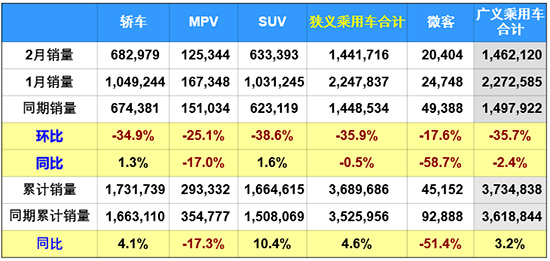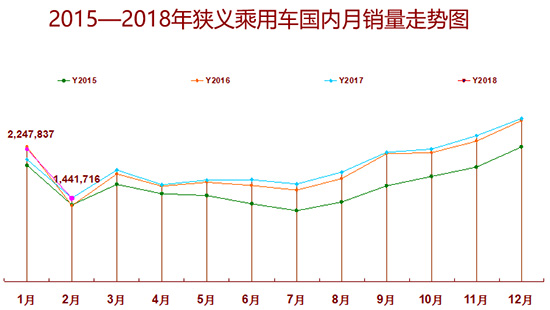In February, the auto market declined slightly by 0.5%. Policies promote the rapid development of new energy
On March 8th, the National Passenger Car Market Information Association (hereinafter referred to as “Chairâ€) released data: In February 2018, the sales volume of narrow passenger vehicles in China was 1,441,716 vehicles, which was a decrease of 0.5% year-on-year and 35.9% month-on-month. The decline was basically in line with the expectations of the CCC; in January-February, China's narrow sales of passenger vehicles accumulated sales of 3,689,686 vehicles, an increase of 4.6% year-on-year, which is a significant improvement from the 2% drop in the same period last year.

In response, Cui Dongshu, secretary-general of the National Passenger Vehicle Market Information Association, stated that the stable performance of the auto market in February was mainly due to the relatively high sales of automobiles before the Spring Festival, but the slow recovery after the holidays. In addition, consumers' purchase of housing and some of the entire vehicle companies set lower sales targets due to too little production, which indirectly lowered the sales data of the auto market.
Cars and SUVs Continue to Grow in February
In terms of specific models, sales of cars, SUVs, and MPVs in February all showed year-on-year growth; however, sedan and SUVs showed different degrees of growth year-on-year, which was the main driving force for the robust auto market in February; MPV still showed no sign of recovery. , the same period did not stop the downward trend.
Among them, a total of 633,393 SUVs were sold in February, a year-on-year increase of 1.6% and a 38.6% drop from the previous quarter, dragging down the cumulative increase for the first two months to 10.4%. It is worth noting that while the SUV model has continued to grow at a slower pace in the market, it is still an important driver of the growth in overall passenger car sales.
The passenger car that still occupied the largest volume sold a total of 682,979 vehicles in February, a year-on-year increase of 1.3% and a month-on-month decline of 34.9%. In January-February, a total of 1,731,739 cars were sold, an increase of only 4.1% year-on-year. In this regard, Cui Dongshu said that in the case of withdrawal of purchase tax, the positive growth of cars can still be mainly due to the explosive growth of new energy vehicles.
The downturn of the MPV still did not usher in a turning point in February. According to the data, the sales volume of MPV in February was 125,344 units, which was a decrease of 17% and 25.1% from the previous quarter respectively; in January-February, MPV cumulative sales were 293,332 units, a year-on-year decrease of 17.3%. Cui Dongshu believes that the hot sales of SUV will inevitably affect the sales of MPV. At the same time, although the sales of high-end models have surged in the MPV market, the low-end home MPV occupying 90% of the sales volume has continued to slump, resulting in the emergence of a weak pattern in the MPV market.
As for the performance of the auto market in March, Cui Dongshu predicts that due to the low production and channel inventory in February of this year, the characteristics of the supplement inventory in March will be more obvious, and the growth in production and sales should be relatively strong, and eventually realize the first quarter of the industry. The good start.
Of course, the auto market in March also has a negative side. After the Spring Festival, in March, the purchase of cars is more focused on the demand for production data. However, with the changes in population structure and the promotion of new retail, the demand for vehicles in county and township markets and individual industry and commerce has shrunk. According to Cui Dongshu, “the current hot spot for the new growth in the auto market has not yet formed. With the expected reduction in import tariffs, competition in the overall auto market will gradually increase."
In addition, Cui Dongshu also reiterated its forecast for the entire auto market in 2018. He believes that the 5% increase in the auto market in January-February this year is high quality data. It is expected that the overall retail sales growth in the spring will be better, and the wholesale performance of the manufacturers will also improve. This also preliminarily confirms that the CLUCC is expected to stabilize after the auto market in 2018. Growth characteristics. “We always believe that the expected retail sales growth in the auto market in 2018 is 4%, which is stronger than the overall performance in 2017,†Cui Dongshu stressed.

Policies to promote the rapid development of new energy sources for lithium battery recycling
In recent years, the rapid development of new energy vehicles, a total of 29,000 units sold in February, an increase of about 80%; January-February, the accumulated sales of new energy has approached 60,000 vehicles, an important driving force for the growth of the auto market. Cui Dongshu said that with the gradual emergence of favorable policies, the trend of new energy remains relatively strong growth.
In addition, the policy on adjusting and improving the financial subsidy policy for the promotion and application of new energy vehicles was released in February to promote the new energy automotive industry to improve quality, increase efficiency, enhance core competitiveness, and achieve high-quality development, and vigorously support fuel cell vehicles. Encourage the development of pure-electric models and plug-in hybrid high-end passenger vehicles, and further increase the energy density threshold of pure electric passenger cars.
Cui Dongshu stated that "the adjustment of the subsidy policy has undergone many rounds of brewing and analysis. Although the adjustment has been vigorous, the final policy is very good compared to the previous version of the Internet."
According to the policy requirements, the subsidy policy implemented by new energy vehicles in 2018 has achieved effective continuity of product supply and demand. In the first half of this year, new energy passenger cars and passenger cars still implement a 0.7-fold subsidy policy, which ensures that the 2017 new energy model catalog products will be guaranteed in terms of resource supply; in the second half of the year, new energy vehicles will implement new subsidy policies and will increase Both the product and the company's core competitiveness have a good promotion effect. In addition, the development of the peaks of passenger cars and loading vehicles is also a good boost to the steady growth of the battery industry.
It is worth mentioning that the Interim Measures for the Management of the Recycling and Utilization of Power Battery for New Energy Vehicles has also been clearly proposed. The new energy vehicle production enterprises shall assume the main responsibility for the recovery of the power battery, and emphasize that related companies perform in the recycling of power batteries. Responsibility to protect the effective use of battery power and environmental protection.
Auto vehicle companies are mainly responsible for assisting the circulation and recycling of new energy vehicles. Lithium batteries for vehicle battery recycling and recycling require the joint efforts of the society. Cui Dongshu proposes that “in the future, all cities and localities should have complete and unified recycling of lithium batteries. The management system also mobilizes the enthusiasm of the battery manufacturing enterprises, achieves maximum scrapping, dismantling and recycling under the support of policies, and ultimately realizes the recycling of rare metal resources.â€
Airless Sprayer,Piston Pump Airless Paint Sprayer,Airless Paint Sprayer,Piston Airless Paint Sprayer
Fuzhou HVBAN Mechanical Equipment Co., Ltd. , https://www.hi-sprayer.com